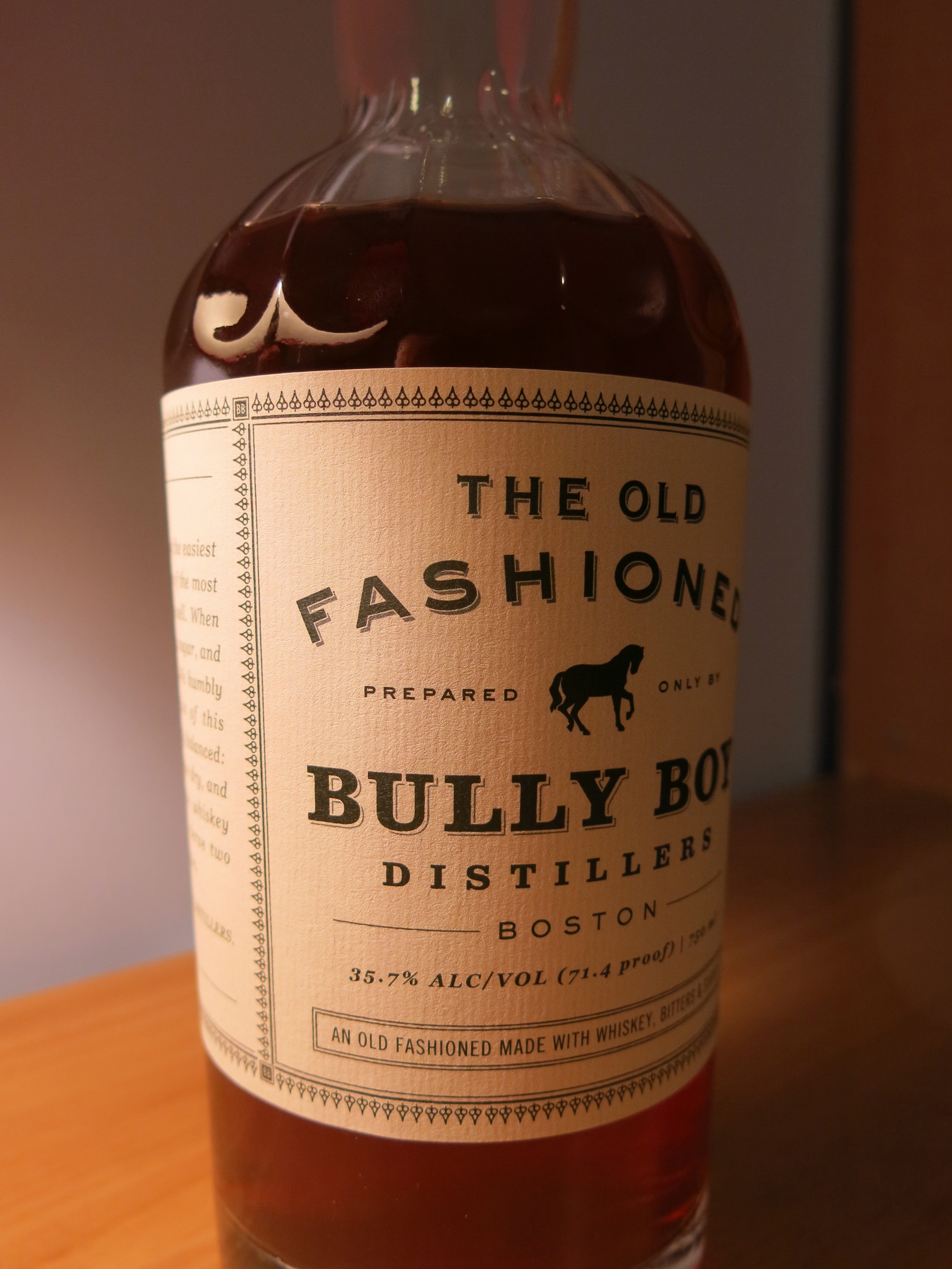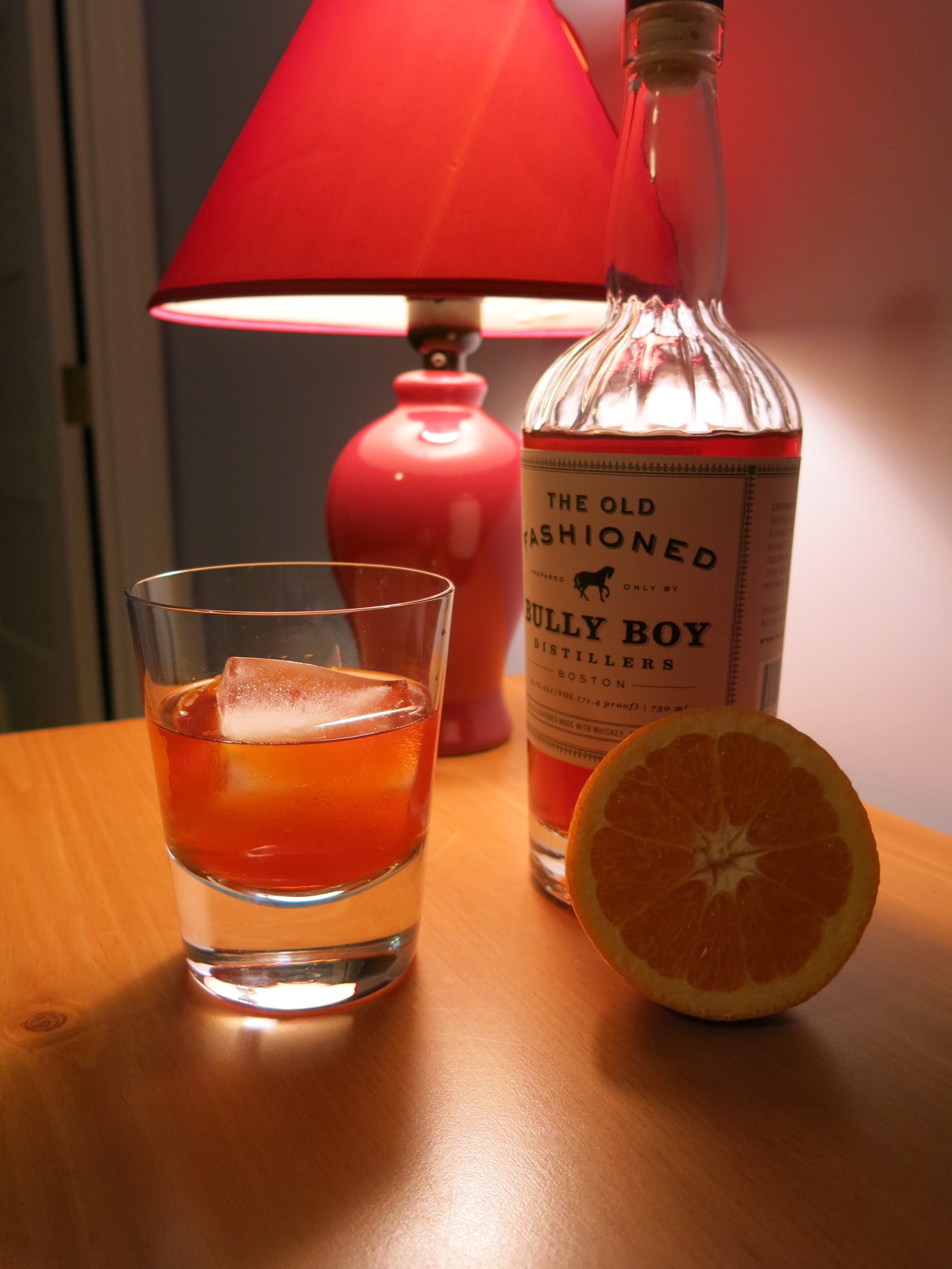Product Review – Bully Boy Old Fashioned
Making an Old Fashioned is easy. Screwing it up is even easier.
The Old Fashioned is one of the oldest and simplest cocktails in the book. It is the very definition of a cocktail – spirit, citrus, bitters, and sweetener. What could possibly go wrong?
Well, if you’ve ever ordered an Old Fashioned and been handed a glass of whiskey served over a graveyard of mutilated fruit and topped with soda water, then you know exactly what can go wrong.
For the record, the Old Fashioned is typically made by dropping a couple dashes of Angostura bitters in a quarter ounce of simple syrup in a rocks glass, muddling an orange peel in the mixture, adding two ounces of whiskey, stirring, and then plopping one or two large ice cubes into the mix. That’s not a definitive recipe, and there are plenty of wonderful variations. Some people use lemon instead of orange, or use the peel as a garnish instead of muddling it. A sugar cube is a classy alternative to syrup. Some drinkers prefer bourbon; others, rye. Even whole slices of muddled fruit are OK, within reason.
And yet this drink has a way of going off the rails. I’m not opposed to having a little fruit in there, but I’ve seen Old Fashioneds served with a mash of orange, lemon, maraschino cherries, even pineapple – sometimes all in the same glass. Then there’s the soda water, which for some reason I find particularly galling.
I’ve read that the trouble began during Prohibition. An Old Fashioned made with whiskey distilled in some guy’s garage was probably vile, so disguising the astringent flavor with fruit and soda was probably wasn’t a half-bad idea. Unfortunately, the practice survived the so-called Noble Experiment and persisted until fairly recently. This glorious craft cocktail renaissance has elevated our standards, and many bartenders have sought to restore the Old Fashioned to its purer, more traditional form.
And yet, even without the extraneous ingredients, a truly exceptional Old Fashioned is hard to come by. Dave Willis, co-owner of Bully Boy Distillers, thinks the most common misstep is not adding enough bitters.
And he blames the bottle. “When you use a bottle of Angostura bitters, it’s really, really difficult to determine how much bitters you’re adding and how much bitters you should add, because it has that odd sort of drip/pouring mechanism,” he explained to me when I visited the Bully Boy distillery back in August. “So I use a lot of bitters.”
Why should you care about how much Angostura Dave uses in an Old Fashioned? Because he’s something of an authority on the matter – as he’ll tell you. “Not to toot my own horn, but I make an unbelievable Old Fashioned,” he humbly declared when we met this summer.
If you don’t believe him, you can try his version for yourself. Last month, Bully Boy released a bottled Old Fashioned made in accordance with Dave and his brother Will’s recipe for this classic cocktail. It’s a limited release product that will be available through the winter months.
While bottled cocktails are becoming more common and improving in quality, there’s still a tendency to be leery of any prepared version of a craft drink. But there’s nothing in Bully Boy’s bottle that doesn’t belong – just whiskey, muddled raw sugar, and Angostura bitters. As for Dave’s comment about using “a lot of bitters,” that’s a phrase that takes on a different meaning when you consider that he and Will acquired a 50-gallon drum of the stuff while they were batching the cocktail. Dave explained that working with such large quantities enabled them to better control the proportions, as opposed to the guesswork that accompanies the drips and dashes from the usual bottle of Angostura.
The base spirit is Bully Boy’s aged American Straight whiskey, made from corn, rye, and malted barley. With flavor notes common to both bourbon and rye whiskey, it’s well suited to an Old Fashioned.
As a lover of Old Fashioneds (and as someone who takes pride in making a respectable one), I can say I’m genuinely impressed with the final product. True to Dave’s good-natured boast, it’s an outstanding interpretation. The ingredients are beautifully balanced – just the right amount of sugar and bitters, and the whiskey is notable for its unique blend of sweet and spicy notes.
The Willis brothers suggest muddling an orange wheel and a maraschino cherry. That’s more fruit than I’d ordinarily use, but the combination does work pretty well. Still, I prefer just an orange peel. With a little less fruitiness, the spicy notes of the whiskey stand out and the flavor of the bitters is more prominent.
Bully Boy hasn’t just idiot-proofed the Old Fashioned; they’ve elevated it. Their bottled product is convenient for anyone who struggles to perfect this classic drink but is good enough to satisfy skeptical connoisseurs.
Will and Dave recommend pouring “two fingers” of the cocktail, a generous and utterly satisfying measure of it, over a large ice cube.
Nowhere do they recommend using soda water.
I received a complimentary bottle of the Old Fashioned from someone associated with Bully Boy. I was neither asked nor expected to write a review of it. The opinions expressed here are, as always, my own.
* * * * * * * * * * * * *
Copyright © Boston BarHopper. All Rights Reserved.
Product Review – Mija Sangria
Bottled mixed drinks have never enjoyed a glowing reputation. I don’t think I’ve ever tried one of those pre-mixed margaritas or daiquiris that can usually be found coated with a layer of dust on the bottom shelf of a liquor store; so, in truth, I can’t say I know they’re terrible. But in the same way that I don’t have to eat a forkful of cat food to know it’s not for me, I’ve always felt comfortable dismissing the pre-mixed cocktail genre in its entirety.
It may seem ironic, then, that in this era of handmade cocktails and fresh ingredients, bottled cocktails are experiencing an upswing in popularity and, more importantly, quality. Plenty of bartenders have been experimenting with carbonated, pre-mixed drinks, and several respected liquor producers have attempted to capture the complexity and freshness of a good cocktail, bottle it, and put it on store shelves.
On one end of the spectrum, there’s Charles Joly, a world-renowned bartender willing to put his name on his own line of bottled cocktails. On the other end, you’ve got those abominations I keep seeing Budweiser advertise, which I guess are maybe beer or some malt beverage that tastes like a cocktail? Honestly, don’t even tell me; I really don’t want to know.
And so it was with a mix of optimism and skepticism that I approached Mija Sangria, a bottled sangria made by Latitude Beverage Company, the founders of 90+ Cellars.
I received a sample of this bottled sangria earlier this month, just in time for the very type of weather that calls for this refreshing wine-based libation.
Why Sangria?
My first thought was this – why go to the trouble of bottling something that’s as easy to make as sangria? (Actually, that’s not true; my first thought was “free booze delivered to my door, YES!!!!”) All you need is a halfway-decent red wine, fresh fruit, maybe some soda, and you’re on your way. Why not bottle something that takes a more practiced hand or requires ingredients that the casual home bartender may not want to invest in?
But I digress.
Presentation
On appearance alone, Mija makes a winning first impression. The bottle is beautifully designed, and its resealable flip-top means you can reuse it. Further, the screen-printed label makes a strong case for the bottle’s contents, describing the sangria as a premium red wine blended with genuine, natural, unfiltered fruit juices.
The accompanying product description sounds promising too – no artificial additives, plenty of antioxidants from fruits such as pomegranate, açai, and blood orange.
How Does it Taste?
Of course, like so many things in life, it’s what’s inside that counts. And I’m happy to say that despite my reservations…it’s pretty good!
First off, it’s actually a sangria, not some flavored mix masquerading as the timeless summertime beverage. It’s full-flavored and well balanced, with a fresh aroma and a very natural fruitiness.
The product description promises pulp, just like a homemade sangria. I was disappointed not to find any in my bottle, but it did have a thick, rich consistency that compensated for any lack of texture.
One Problem
My only real criticism is that it’s too sweet for my taste. Many sangria recipes call for brandy, and I think that’s what’s missing here – an ingredient that adds some complexity, balances the sweetness, and gives the drink some bottom.
I didn’t have any brandy on hand, but experimented with adding a little dark rum. While I didn’t get the proportions quite right, it did contribute some depth.
And the Mija folks actually encourage that sort of experimentation. Although it’s bottled ready to drink, the serving notes suggest it can be used as a cocktail ingredient or as a base for your own sangria. So if it feels incomplete, depending on your taste, it will stand up to some customization.
To Make or to Buy
Given the choice, I’m always going to prefer making my own sangria. I get excited about spending hours looking up the best recipes, experimenting with different batches, and eventually settling on my own interpretation.
But I realize not everyone has the time or inclination for that. Plus, the best homemade sangrias tend sit for a while to let the flavors come together, and it’s hard to argue with the comparative ease of grabbing a bottle at the liquor store on the way to a summer party.
In that respect, I can definitely understand the appeal of a quality bottled sangria.
And while I may quibble with the sweetness and crave some more complexity, there’s one thing about Mija I should make abundantly clear – if you simply handed me a glass of it, I would never guess that it came from a bottle. Nothing about it tastes, smells, or looks processed, and being able to capture that freshness is a genuine achievement.
Note: The bottle of Mija sangria I received was complimentary. I was not asked or expected to review or promote it in any way, shape, or form.
* * * * * * * * * * * * *
Copyright © Boston BarHopper. All Rights Reserved.











